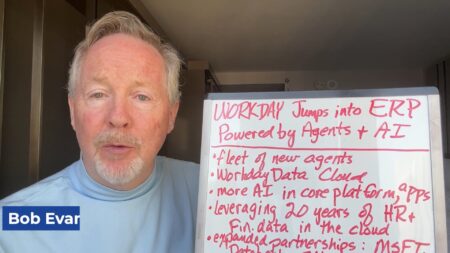Following Cloud Wars’ Industry Cloud Battleground last week and the focus on patient-centric healthcare, I’ve outlined eight opportunities for business leaders as they look to transform their processes and operations.
First, we should acknowledge that interoperability standards like FHIR allow for surfacing patient data to industry clouds without sacrificing security, which in turn creates many significant use cases for patient-centric care. While most FHIR implementations today are read-only, new federal regulations are being proposed for 2022 that will address write capabilities. The ability to write back to the EHR will continue to extend the list of potential use cases.
1. Direct Scheduling
Scheduling was one of the first use cases for computers in healthcare, beginning in the 1990’s. Today, implementing direct scheduling using online appointments and integrating with industry cloud capabilities such as omni-channel, machine learning, and CRM can help reduce the complexities of scheduling patient-centric care.
Only about 37% of provider appointments happen during regular hours and relying on patient portals and EHR technology for communications and appointment reminders is not enough today. Healthcare consumers expect more when it comes to scheduling and preparing for visits.
Adding links to appointment services during your CRM marketing campaigns can help increase patient visits. In addition, the marketing campaigns can be implemented and tracked using the patient journey capabilities of industry clouds.
2. Omnichannel Communications
Consumers use texting in many parts of life already and feel comfortable interacting via text messaging. Technologies like omnichannel communications can be extended to industry clouds for healthcare, and some vendors already have omnichannel communications built into their offerings.
Allowing chat and text messaging to be part of the scheduling, care-plan tracking, and payment workflows can increase response rates, reduce missed appointments and increase revenue. To benefit from these use cases, decision makers will want to pay attention to omnichannel and workflow features from cloud providers.
3. Patient Education
The C-Suite needs to consider patient education and shared decision-making as an integral part of a patient-centric approach. Common scenarios include helping patients prepare for telehealth visits, increased awareness for mental health at the point of care, and targeted information for those who should be screened for cancer.
It’s worth noting that with the rise in video, many patients are turning to instructional videos, i.e. “How to prepare for a colonoscopy.” This kind of training can reduce return visits for repeat exams. In fact, Cleveland Clinic patients who viewed the Emmi colonoscopy videos were nearly 50% less likely to need a repeat endoscopy within three years compared to patients who did not view the video.
Giving patients access to specific educational content via QR codes is considered a great option by nurses. The features to disseminate, collaborate on, and analyze patient education assets are available in industry clouds today.
4. Telehealth
Over the past 18 months, telehealth has seen exponential growth and has helped health organizations fill gaps in care. There are obvious components of telehealth, such as video meeting platforms. However, many organizations are using different workflows for traditional visits vs. telehealth visits. Cloud workflow and business process technologies make it possible to combine and extend patient-centered telehealth workflow and business processes.
In addition, combining video, omnichannel communications, and business processes greatly streamlines telehealth efforts. It’s also worth noting that healthcare providers and others are looking at how telehealth can help underserved populations access care, such as reducing bias in treatment and lack of care access in rural areas.
5. Remote Patient Monitoring
Edge computing and cloud services are creating compelling use cases in connected health and Remote Patient Monitoring (RPM). Remote medication management apps and wearables allow patients to upload data to patient portals. In some cases, this can be done automatically. Devices that are common today in RPM platforms include blood pressure cuffs, thermometers, blood glucose monitors, pulse oximeters, and weight scales. This list is continuing to expand, creating additional use cases in RPM rapidly.
Transportation has an effect on patient wellness because it directly impacts whether or not a patient can access her healthcare. When a patient has transportation barriers, they are less likely to attend a wellness check, chronic disease management appointment, or follow-up care. A pilot RPM effort for health organizations can be as simple as phone or text check-ins using cloud omnichannel case management features.
6. Provider Services
Many healthcare organizations have created Provider Service departments to increase the satisfaction of physicians and health providers. A Provider Services department can maximize a physician’s compensation, protect time, and track the clinical FTE while addressing physician burnout. The collaboration features, electronic forms, and workflows embedded in healthcare cloud services can assist healthcare organizations in enhancing provider services.
7. Improve Payor, Payee Transactions
According to the 1 2019 CAQH Index® report, paper-based transactions account for nearly $350 billion in administrative costs annually in the U.S. health system. The report also notes that switching to electronic payments could save the industry an estimated $135 million each year.
Using consumer-to-business and business-to-business electronic payments can reduce payment complexities. Embedding electronic payment options and using CRM features to streamline payment support is a good way to avoid patient leakage due to billing process dissatisfaction.
8. Clinical NLP to Increase Patient Satisfaction
Health organizations have known that increased patient satisfaction leads to better health outcomes and better adherence to treatment plans. A new opportunity for executive leadership is adding machine learning combined with analytics to improve the analysis of patient surveys. Clinically intelligent NLP (Natural Language Processing) can assist in capturing unstructured data from care plans and provider notes to enhance the survey data and provide a complete dataset to analyze outcomes.
An easy pilot project for machine learning and patient satisfaction might be intelligent bots to collect survey data at patient touch-points. Organizations can use cloud-based case management capabilities for healthcare to enhance response time to surveys that require immediate assistance.
Patient survey bots are a great use case for omnichannel and text integration. For enhanced decision-making, the outcomes data gathered from patient surveys and NLP can be surfaced using dashboards and goal scorecards.
Summary
I hope my list of use cases illustrates compelling reasons for both healthcare leaders and their technology providers to deploy and refine industry cloud infrastructure that supports patient-centric care. These emerging capabilities offer great promise for improving and extending healthcare services to people around the world.






